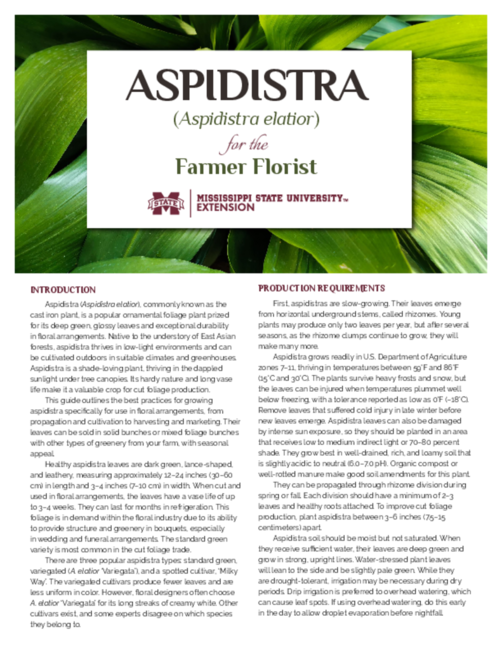P4138
Aspidistra (Aspidistra elatior) for the Farmer Florist
Introduction
Aspidistra (Aspidistra elatior), commonly known as the cast iron plant, is a popular ornamental foliage plant prized for its deep green, glossy leaves and exceptional durability in floral arrangements. Native to the understory of East Asian forests, aspidistra thrives in low-light environments and can be cultivated outdoors in suitable climates and greenhouses. Aspidistra is a shade-loving plant, thriving in the dappled sunlight under tree canopies. Its hardy nature and long vase life make it a valuable crop for cut foliage production.
This guide outlines the best practices for growing aspidistra specifically for use in floral arrangements, from propagation and cultivation to harvesting and marketing. Their leaves can be sold in solid bunches or mixed foliage bunches with other types of greenery from your farm, with seasonal appeal.
Healthy aspidistra leaves are dark green, lance-shaped, and leathery, measuring approximately 12–24 inches (30–60 cm) in length and 3–4 inches (7–10 cm) in width. When cut and used in floral arrangements, the leaves have a vase life of up to 3–4 weeks. They can last for months in refrigeration. This foliage is in demand within the floral industry due to its ability to provide structure and greenery in bouquets, especially in wedding and funeral arrangements. The standard green variety is most common in the cut foliage trade.
There are three popular aspidistra types: standard green, variegated (A. elatior ‘Variegata’), and a spotted cultivar, ‘Milky Way’. The variegated cultivars produce fewer leaves and are less uniform in color. However, floral designers often choose A. elatior ‘Variegata’ for its long streaks of creamy white. Other cultivars exist, and some experts disagree on which species they belong to.
Production Requirements
First, aspidistras are slow-growing. Their leaves emerge from horizontal underground stems, called rhizomes. Young plants may produce only two leaves per year, but after several seasons, as the rhizome clumps continue to grow, they will make many more.
Aspidistra grows readily in U.S. Department of Agriculture zones 7–11, thriving in temperatures between 59°F and 86°F (15°C and 30°C). The plants survive heavy frosts and snow, but the leaves can be injured when temperatures plummet well below freezing, with a tolerance reported as low as 0°F (–18°C). Remove leaves that suffered cold injury in late winter before new leaves emerge. Aspidistra leaves can also be damaged by intense sun exposure, so they should be planted in an area that receives low to medium indirect light or 70–80 percent shade. They grow best in well-drained, rich, and loamy soil that is slightly acidic to neutral (6.0–7.0 pH). Organic compost or well-rotted manure make good soil amendments for this plant.
They can be propagated through rhizome division during spring or fall. Each division should have a minimum of 2–3 leaves and healthy roots attached. To improve cut foliage production, plant aspidistra between 3–6 inches (7.5–15 centimeters) apart.
Aspidistra soil should be moist but not saturated. When they receive sufficient water, their leaves are deep green and grow in strong, upright lines. Water-stressed plant leaves will lean to the side and be slightly pale green. While they are drought-tolerant, irrigation may be necessary during dry periods. Drip irrigation is preferred to overhead watering, which can cause leaf spots. If using overhead watering, do this early in the day to allow droplet evaporation before nightfall.
A balanced, slow-release NKP fertilizer (10-10-10 or 14-14-14) should be applied during the spring and summer. Micronutrient fertilizers can result in a deep green leaf color.
Pest and Disease Management
Aspidistra is generally pest-resistant, but some insects can cause damage to this plant. Scale insects appear as small, white or brown bumps on the leaves, particularly at the base of the leaf. Mites can also infest aspidistra, and heavy infestations cause yellowing at the leaf terminals. Horticultural oil is not recommended for controlling these insects because it penetrates the leaves and causes mottling on aspidistra. Professional growers can use systemic insecticides labeled for these insects. Continual scouting will help prevent insects from spreading.
Fusarium can infect aspidistra, especially when the leaves are continually wet, such as the result of overhead irrigation. If using overhead irrigation, water the plant when the foliage will dry rapidly. Remove infected leaves and seek fungicides labeled for aspidistra if needed.
Harvesting and Postharvest Handling
Harvest mature leaves year-round using pruning shears or a sharp knife. Do not remove more than 30–40 percent of the leaves from a single plant. Doing this will reduce the plant’s ability to make and store carbohydrates, which are produced during photosynthesis in the leaves.
Once leaves are harvested, wash them in lukewarm water to remove dirt and insects. Grade the leaves and gather some with similar sizes in bunches of 10. The bunches can be packed in boxes lined with plastic sheeting and stored in refrigeration. Store at 40–50°F (5–10°C) with high humidity (90–95 percent). Many florists purchase cut aspidistra leaves throughout the year, and wholesale prices vary; therefore, it is recommended to check the local wholesale marketplace for competitive pricing.
Aspidistra leaves are combined with liriope (Liriope muscari) and corkscrew willow (Salix matsudana) to create visual movement in floral arrangements.

Leafwork Techniques
Floral designers in garden clubs, florist studios, and flower shops like using aspidistra leaves to create distinctive arrangements. The following images show a few leaf manipulation techniques, also known as leafwork, applied to aspidistra.
Curled Leaf
Curl the leaf so that the leaf top faces outward. Puncture the leaf blade with its petiole. The curved unit can be inserted into the floral design mechanics or as a placement in a handtied bouquet.
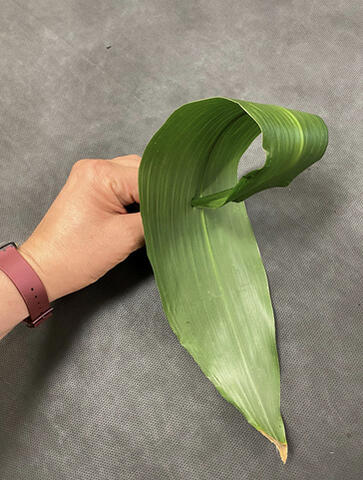
Jagged Leaf
Cut small triangles from the leaf margin to create a new, distinctive shape, like a banana leaf.

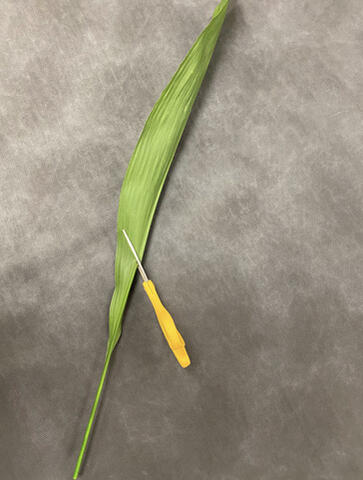
Torn Leaf
1. Lightly fold the leaf in half, then, using a pair of multipurpose shears, snip the midvein of the aspidistra leaf.
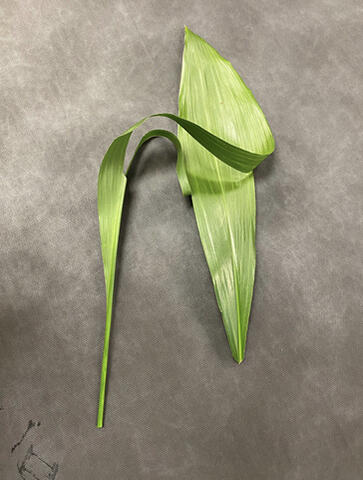
2. Tear the margins away from the cut, but do not fully separate the leaf into two pieces.
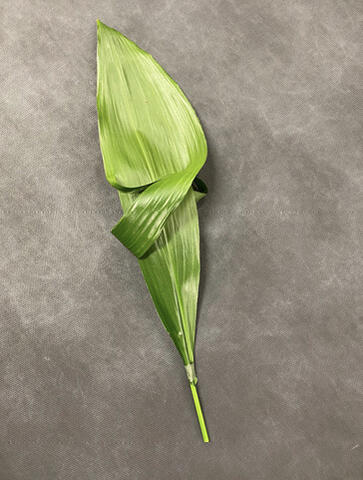
3. When using the leaf in a design, take care to maintain space between the two units. In this image, we have rotated the leaf about its axis so that its margins display a shape like a calla lily’s shape. We added a small amount of clear tape at the base of the leaf blade to secure the units together.

Gilded Leaf
Aspidistra can be tinted using floral spray paints. In this example, we applied paint to the underside of the leaf, revealing just a glimmer of gold in floral designs.
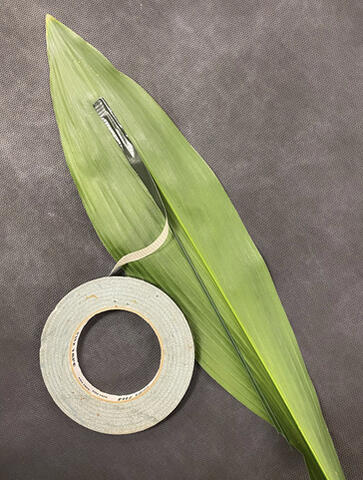
Zigzag Leaf
1. In this application, we will provide an aspidistra leaf with a wire backbone. An easy way to do this is to attach an 18-gauge wire or a similar gauge using florists’ waterproof tape to the underside of the leaf. Ensure the leaf is clean and dry to guarantee proper attachment. Keep the wire as close to the midvein as possible while taping it in place.
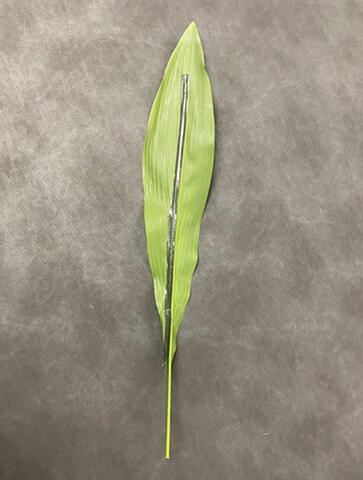
2. The wire should run along most of the midvein’s length.
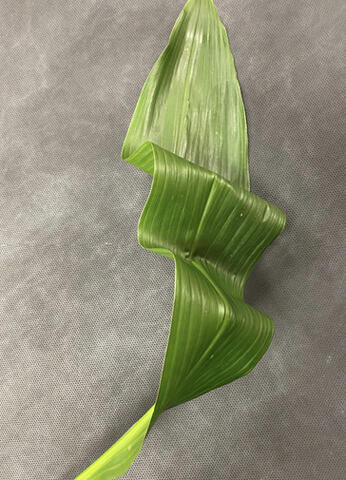
3. A wire backbone will hold bends in place, allowing designers to build unusual lines into their floral creations.
Resources
- For more information about cut ornamental crops, refer to the following Mississippi State University Extension publications:
- MSU Extension offers floral design training certificates for consumers and professionals.
References
Missouri Botanical Garden. (n.d.). Aspidistra elatior.
Plant Delights Nursery. (n.d.). Aspidistra – tough cast iron plants for the perennial garden or container.
University of Florida Extension. (n.d.). Aspidistra production and use [PDF file].
The information given here is for educational purposes only. References to commercial products, trade names, or suppliers are made with the understanding that no endorsement is implied and that no discrimination against other products or suppliers is intended.
Publication 4138 (POD-10-25)
By James M. DelPrince, PhD, AIFD, PFCI, Associate Extension Professor, Coastal Research and Extension Center.
The Mississippi State University Extension Service is working to ensure all web content is accessible to all users. If you need assistance accessing any of our content, please email the webteam or call 662-325-2262.
